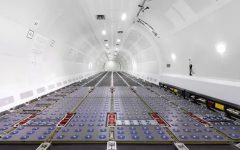
Rajen Bhatia, MD, Tulsidas Khimji said, “With Chhatrapati Shivaji Maharaj International Airport (CSMIA) temporarily suspending freighter operations due to ongoing infrastructure upgrades, the spotlight now shifts to Navi Mumbai International Airport (NMIA). The pressing question: Is NMIA prepared to take on the cargo baton? This transition is more than a simple logistical rerouting—it is a live stress test of NMIA’s readiness to manage large-scale freighter operations. While the airport is being developed with world-class infrastructure, it has yet to demonstrate its capabilities under real-time operating conditions. Critical elements like efficient cargo handling, streamlined customs clearance, and strong road connectivity will be essential to maintain business continuity during this period.
To complicate matters, the decision to shift operations by mid-August 2025 appears to have been made without full stakeholder consultation. This abrupt timeline risks disrupting the smooth flow of cargo and may leave many stakeholders underprepared.
Current Readiness and Gaps
CSMIA currently handles four to five freighter flights daily. Although NMIA’s runway and taxiways are reportedly ready, the cargo-specific infrastructure is still under development. For NMIA to function as a viable cargo hub, the following must be fully operational:
- Dedicated areas for cargo handling, storage, and processing
- Specialized zones for hazardous and perishable goods
- Customs clearance including customs office / staff and inspection facilities
- Office space for cargo agents, freight forwarders, customs brokers
Key Concerns and Potential Disruptions
The logistics industry is preparing for a series of short-term challenges that may arise from this sudden transition:
- Transit Delays: Unfamiliarity with new routes and procedures could result in delayed shipments
- Higher Logistics Costs: Longer lead times and last-mile delivery changes may increase operational expenses
- Teething Issues: Handlers, transporters, and support staff will need time to adapt to the new environment
- Risk to Time-Sensitive Shipments: If cold chain systems, warehousing, and customs processes aren’t fully operational, sensitive cargo could face delays
- Connectivity Concerns: Road access from key logistics hubs across Mumbai and Maharashtra must be seamless to avoid bottlenecks
- Stakeholder Coordination Gaps: Lack of synchronization between airport authorities, ground handlers, freight forwarders, and regulatory bodies could create operational friction
Opportunities Amidst the Challenges
Despite the near-term hurdles, NMIA has strong potential to evolve into a streamlined, future-ready cargo hub. With less congestion than CSMIA, it may eventually offer faster turnaround times, greater scalability, and enhanced operational efficiency—if the transition is managed with foresight.
The Way Forward
For this shift to succeed, the following steps are essential:
- Clear, consistent communication from NMIA authorities
- Transparent timelines and regular operational updates
- Collaborative planning across the logistics ecosystem—airlines, agents, ground handlers, and regulators
This shift marks a pivotal moment for Mumbai’s air cargo sector. While challenges are inevitable, proactive planning and unified efforts can lay the foundation for a stronger, more resilient logistics ecosystem—one that is better equipped to handle the demands of a fast-evolving global trade landscape.”
 Cargo Breaking News
Cargo Breaking News


